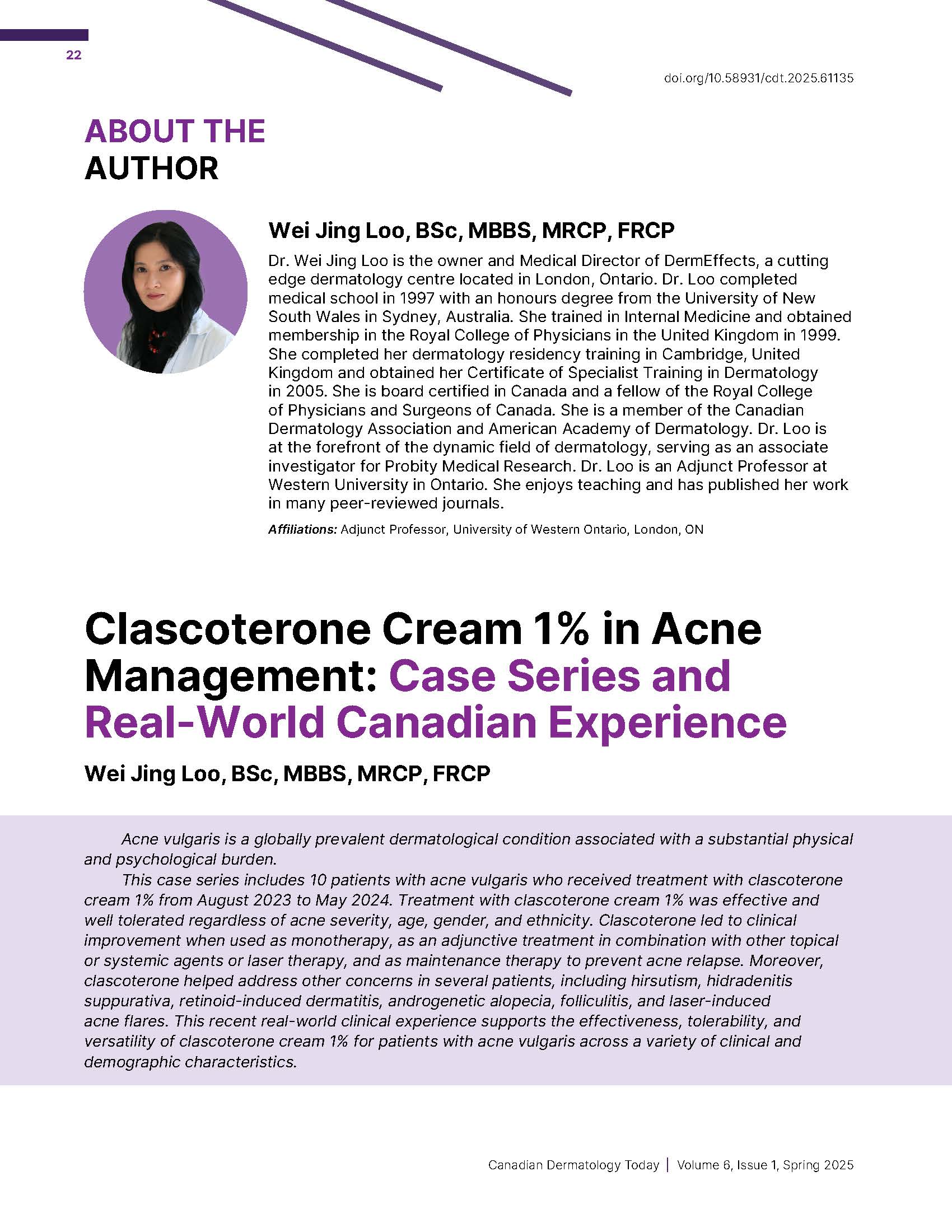Clascoterone Cream 1% in Acne Management: Case Series and Real-World Canadian Experience
DOI:
https://doi.org/10.58931/cdt.2025.61135Abstract
Acne vulgaris is a globally prevalent dermatological condition associated with a substantial physical and psychological burden.
This case series includes 10 patients with acne vulgaris who received treatment with clascoterone cream 1% from August 2023 to May 2024. Treatment with clascoterone cream 1% was effective and well tolerated regardless of acne severity, age, gender, and ethnicity. Clascoterone led to clinical improvement when used as monotherapy, as an adjunctive treatment in combination with other topical or systemic agents or laser therapy, and as maintenance therapy to prevent acne relapse. Moreover, clascoterone helped address other concerns in several patients, including hirsutism, hidradenitis suppurativa, retinoid-induced dermatitis, androgenetic alopecia, folliculitis, and laser‑induced acne flares. This recent real-world clinical experience supports the effectiveness, tolerability, and versatility of clascoterone cream 1% for patients with acne vulgaris across a variety of clinical and demographic characteristics.
References
Reynolds RV, Yeung H, Cheng CE, Cook-Bolden F, Desai SR, Druby KM, et al. Guidelines of care for the management of acne vulgaris. J Am Acad Dermatol. 2024;90(5):1006.e1001–1006.e1030. doi:10.1016/j.jaad.2023.12.017
WINLEVI® (clascoterone cream 1%). Sun Pharma Canada Inc., Brampton, Ontario: Product Monograph. [Updated June 15, 2023, Cited January 9, 2025]. Available from: https://pdf.hres.ca/dpd_pm/00071308.PDF
WINLEVI® (clascoterone cream 1%). Sun Pharmaceutical Industries, Inc. Cranbury, NJ: Full Prescribing Information. [Updated March 1, 2023, Cited January 9, 2025]. Available from: https://www.drugs.com/pro/winlevi.html
Hebert A, Thiboutot D, Stein Gold L, Cartwright M, Gerloni M, Fragasso E, et al. Efficacy and safety of topical clascoterone cream, 1%, for treatment in patients with facial acne: two phase 3 randomized clinical trials. JAMA Dermatol. 2020;156(6):621–630. doi:10.1001/jamadermatol.2020.0465
Chu L, Gold S, Harris C, Lawley L, Gupta P, Tangpricha V, et al. Incidence and factors associated with acne in transgender adolescents on testosterone: a retrospective cohort study. Endocr Pract. 2023;29(5):353–355. doi:10.1016/j.eprac.2023.02.002
Radi R, Gold S, Acosta JP, Barron J, Yeung H. Treating acne in transgender persons receiving testosterone: a practical guide. Am J Clin Dermatol. 2022;23(2):219–229. doi:10.1007/s40257-021-00665-w
Mazzetti A, Moro L, Gerloni M, Cartwright M. Pharmacokinetic profile, safety, and tolerability of clascoterone (cortexolone 17-alpha propionate, CB-03-01) topical cream, 1% in subjects with acne vulgaris: an open-label phase 2a study. J Drugs Dermatol. 2019;18(6):563.
Lynde C, Abdulla S, Andriessen A, Hanna S, Jafarian F, Li M, et al. Real-world cases of clascoterone topical treatment for acne and related disorders. J Drugs Dermatol. 2025;24:1(Supple 2):s3-14. doi: 10.36849/JDD.73361
Cunningham KN, Moody K, Alorainy M, Rosmarin D. Use of topical clascoterone for the treatment of hidradenitis suppurativa. JAAD Case Rep. 2023;36:38–39. doi:10.1016/j.jdcr.2023.04.002
Der Sarkissian SA, Sun HY, Sebaratnam DF. Cortexolone 17alpha-propionate for hidradenitis suppurativa. Dermatol Ther. 2020;33(6):e14142. doi:10.1111/dth.14142
Hargis A, Yaghi M, Maskan Bermudez N, Lev-Tov H. Clascoterone in the treatment of mild hidradenitis suppurativa. J Am Acad Dermatol. 2024;90(1):142–144. doi:10.1016/j.jaad.2023.08.064
Sun HY, Sebaratnam DF. Clascoterone as a novel treatment for androgenetic alopecia. Clin Exp Dermatol. 2020;45(7):913–914. doi:10.1111/ced.14292
Cartwright M, Mazzetti A, Moro L, Caridad R, Gerloni M. A summary of in vitro, phase I, and phase II studies evaluating the mechanism of action, safety, and efficacy of clascoterone (cortexolone 17a propionate, CB-03-01) in androgenetic alopecia. J Am Acad Dermatol. 2019;81(4):AB13. doi:10.1016/j.jaad.2019.06.087


